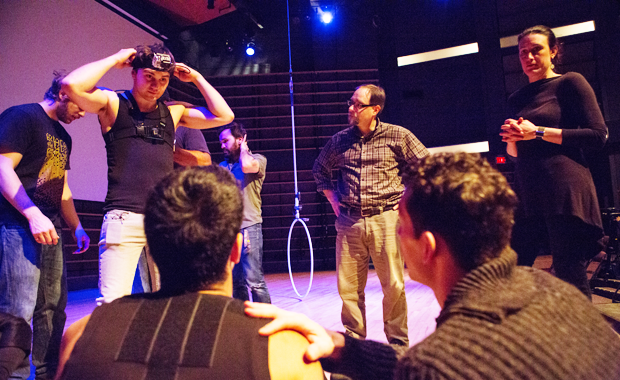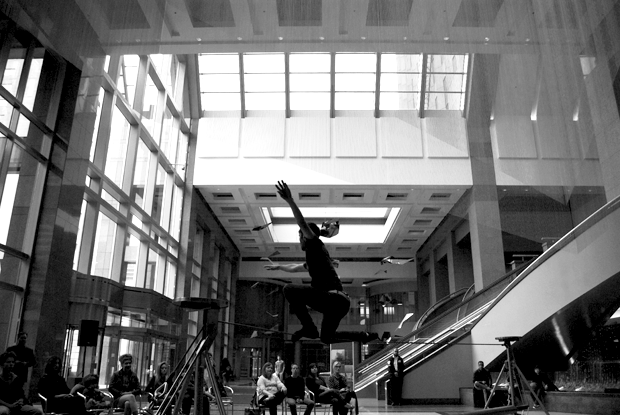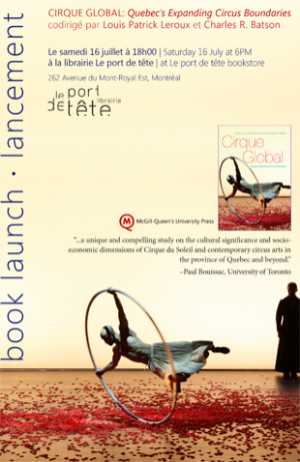So what exactly is circus scholarship?
LPL: Like any performing art, contemporary circus can be studied for its aesthetics, its history, its social pertinence, its pedagogy and training, its architectural impact, its sociological and urban economic imprint — especially in the case of Montreal's Cité des arts du cirque in the Saint-Michel neighbourhood.
I would say what distinguishes contemporary circus in Quebec is the heavy cultural and political capital that comes with it. The Québécois love their circus; they love its worldwide success. They love that while other provinces build cars, fish or forage for oil, we actually export creativity and know-how and sell dreams and vicarious projections onto bodies doing the impossible. Circus, in this case, is a sociological phenomenon and construct; it can be studied in the context of para-diplomacy, nation branding, as well as through other lenses.
Also, circus — as it is practised here and now — relies on notions of performance and risk which draw up two distinct fields and understandings of the terms: the performing arts (dance and theatre) and exercise science (and its own notions of performance and risk management).
Finally, Quebec's circus has also been a savvy combination of entertainment and commerce, of high and low culture, of physicality and artistry. It has tended to be non-verbal in a city that placed language and culture above all for decades, but which has repositioned itself
as an incubator of ideas and creativity. Circus scholarship as it is emerging here examines all of this. It is fundamentally transdisciplinary and relies on a veritable dialogue between colleagues, scholars and practitioners.
How did Quebec reinvent circus traditions?
LPL: Quebec's own circus tradition — before the fabled creation of the National Circus School following the model of the Soviet art circus schools in the early 1980s and the founding of Cirque du Soleil — was very little known, except through a few notable exceptions during the 19th century … Cirque Louis Cyr, the Harland (Leroux) Brothers, Louis Durand.
We were a great exporter of mostly anonymous and adaptable talent to the great American touring circuses. But, over the past 30 years, with the emergence of post-animal spectacles relying on acrobatic exceptionalism, theatrical narrative, new world music and a high-art allure that appealed to a broad audience, Quebec contemporary circus first won over North American audiences and imposed a new aesthetic, a new commercially viable art-circus. Other companies, such as Cirque Éloize, Les 7 doigts de la main and others followed.
Today, Quebec circus training and its "big three" companies have become world references — often against which to resist, which in a sense is also a sign of success!
How has Quebec expanded circus boundaries?
LPL: To borrow from a faded empire's motto: the sun now never sets on Quebec circus activities. Quebec circus is everywhere, on every continent. Contemporary circus has permeated popular culture (the Grammies, the Oscars, the Super Bowl) and is now taught in most Quebec schools as a regular part of physical education.
By not tapping into an existing tradition, it also allowed itself to borrow from theatre, from dance, from very different traditions of circus, mixing unexpected disciplines, seeking to innovate, looking for “newness,” to dazzle and surprise, and to consider that there are no limits to our imaginations, nor to the miles or years that a show can travel.
How did Montreal become such a hotbed of circus activity?
LPL: Quite simply, Cirque du Soleil's exponential success worldwide and specifically its eight permanent shows in Las Vegas generated a billion-dollar industry centred in Montreal. Cirque du Soleil established and maintained its headquarters here. Montreal’s National Circus School, one of the most highly recognized schools in its field in the world, constantly attracts the strongest students. A number of feeder schools and independent studios are also in Montreal, as are a few hundred local and international circus performers who use the city as their base.
An openness to contemporary circus practices, a creative environment, cheap rent and a concentration of major employers in circus have all contributed to making Montreal such an important circus hub. It was only a matter of time for academia to catch up and for us to study and engage with the circus milieu.
What prompted the idea for the new book, Cirque Global: Quebec’s Expanding Circus Boundaries?
LPL: The book started off initially as a call for papers for an inaugural conference I organized at Concordia in 2012, where I wanted to establish a sustained conversation between scholars from many disciplines using very different methodologies and theory whose research object intersected with contemporary circus in Quebec.
After the conference, a number of colleagues continued working on their papers and turned them into fine articles. I also solicited many new ones and sought out a few ”key” texts that had been previously published in French and had them translated by Concordia translation students.
My American colleague Charles R. Batson from Union College joined me to edit the resulting book, Cirque Global, which has just come out with McGill-Queen's University Press and is a foundational publication for North American circus studies and more specifically circus in and from Quebec.
Learn more about Quebec circus at the launch of Cirque Global: Quebec’s Expanding Circus Boundaries on Saturday, July 16 at 6:00 p.m., at Le Port de Tête bookstore — 262 Mount Royal Avenue East, Montreal. The launch is free and open to all. Refreshments will be served.
Thumbnail and banner image courtesy of the Cirque du Soleil.



 “While I didn't quite run away and join the circus, I certainly do spend much of my research and creative time on it,” says Louis Patrick Leroux. | Photo by Concordia University
“While I didn't quite run away and join the circus, I certainly do spend much of my research and creative time on it,” says Louis Patrick Leroux. | Photo by Concordia University
 Photo by Clara Nencu
Photo by Clara Nencu
 Cirque Global, the new book on Quebec’s expanding circus boundaries, will launch July 16.
Cirque Global, the new book on Quebec’s expanding circus boundaries, will launch July 16.


